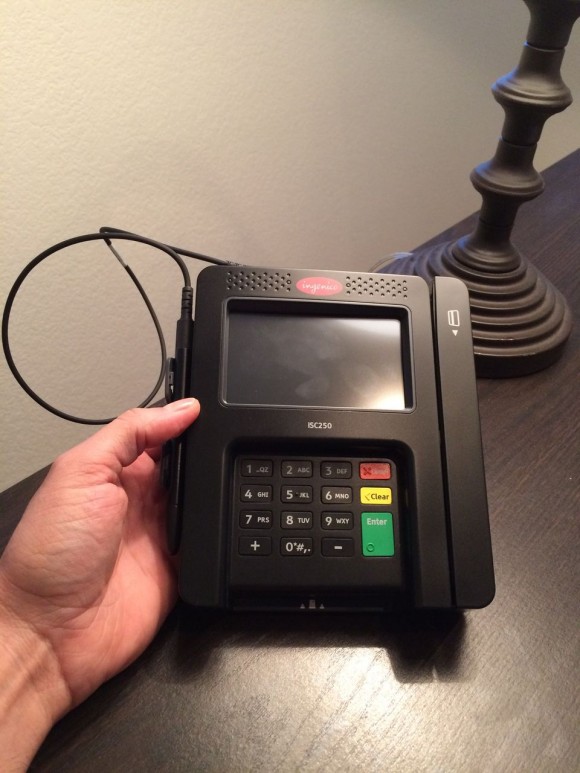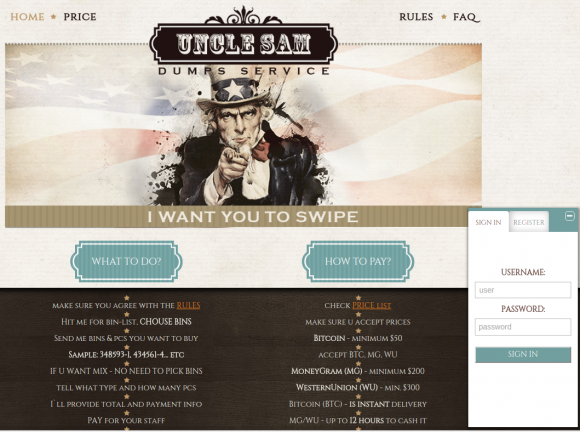Recent local news stories about credit card skimmers found in self-checkout lanes at some Walmart locations reminds me of a criminal sales pitch I saw recently for overlay skimmers made specifically for the very same card terminals.
Much like the skimmers found at some Safeway locations earlier this year, the skimming device pictured below was designed to be installed in the blink of an eye at self-checkout lanes — as in recent incidents at Walmart stores in Fredericksburg, Va. and Fort Wright, Ky. In these attacks, the skimmers were made to piggyback on card readers sold by payment solutions company Ingenico.

A skimmer made to be fitted to an Ingenico credit card terminal of the kind used at Walmart stores across the country. Image: Hold Security.
This Ingenico “overlay” skimmer has a PIN pad overlay to capture the user’s PIN, and a mechanism for recording the data stored on a card’s magnetic stripe when customers swipe their cards at self-checkout aisles. The wire pictured at the bottom is for offloading the data from the card skimmers once thieves have retrieved the devices from compromised checkout lanes.
This particular skimmer retails for between $200 to $300, but that price doesn’t include the electronics that power the device and store the stolen card data.
Here’s how this skimmer looks when it’s attached. Think you’d be able to spot it?
Walmart last year began asking customers with more secure chip-enabled cards to dip the chip instead of swipe the stripe. Chip-based cards are more expensive and difficult for thieves to counterfeit, and they can help mitigate the threat from most modern card-skimming methods that read the cardholder data in plain text from the card’s magnetic stripe. Those include malicious software at the point-of-sale terminal, as well as physical skimmers placed over card readers at self-checkout lanes. Continue reading





 Over the past weekend, KrebsOnSecurity began hearing from sources at multiple financial institutions who said they’d detected a pattern of fraudulent charges on customer cards that were used at various Noodles & Company locations between January 2016 and the present.
Over the past weekend, KrebsOnSecurity began hearing from sources at multiple financial institutions who said they’d detected a pattern of fraudulent charges on customer cards that were used at various Noodles & Company locations between January 2016 and the present. The 2012 breach was first exposed when a hacker posted a list of some 6.5 million unique passwords to a popular forum where members volunteer or can be hired to hack complex passwords. Forum members managed to crack some the passwords, and eventually noticed that an inordinate number of the passwords they were able to crack contained some variation of “linkedin” in them.
The 2012 breach was first exposed when a hacker posted a list of some 6.5 million unique passwords to a popular forum where members volunteer or can be hired to hack complex passwords. Forum members managed to crack some the passwords, and eventually noticed that an inordinate number of the passwords they were able to crack contained some variation of “linkedin” in them. Redmond made the announcement almost as a footnote in its Windows 10 Experience blog, but the feature caused quite a stir when the company’s flagship operating system first debuted last summer.
Redmond made the announcement almost as a footnote in its Windows 10 Experience blog, but the feature caused quite a stir when the company’s flagship operating system first debuted last summer.

 “Based on the preliminary findings of the investigation and other information, the Company believes that malware, installed through the use of compromised third-party vendor credentials, affected one particular point of sale system at fewer than 300 of approximately 5,500 franchised North America Wendy’s restaurants, starting in the fall of 2015,” Wendy’s disclosed in their first quarter financial statement today. The statement continues:
“Based on the preliminary findings of the investigation and other information, the Company believes that malware, installed through the use of compromised third-party vendor credentials, affected one particular point of sale system at fewer than 300 of approximately 5,500 franchised North America Wendy’s restaurants, starting in the fall of 2015,” Wendy’s disclosed in their first quarter financial statement today. The statement continues: erabilities (flaws that attackers figure out how to exploit before before the software maker does) in Internet Explorer (IE) and in Windows. Half of the 16 patches that Redmond issued today earned its “critical” rating, meaning the vulnerabilities could be exploited remotely through no help from the user, save for perhaps clicking a link, opening a file or visiting a hacked or malicious Web site.
erabilities (flaws that attackers figure out how to exploit before before the software maker does) in Internet Explorer (IE) and in Windows. Half of the 16 patches that Redmond issued today earned its “critical” rating, meaning the vulnerabilities could be exploited remotely through no help from the user, save for perhaps clicking a link, opening a file or visiting a hacked or malicious Web site.
 Patterson, N.J.-based ADP provides payroll, tax and benefits administration for more than 640,000 companies. Last week, U.S. Bancorp (U.S. Bank) — the nation’s fifth-largest commercial bank — warned some of its employees that their W-2 data had been stolen thanks to a weakness in ADP’s customer portal.
Patterson, N.J.-based ADP provides payroll, tax and benefits administration for more than 640,000 companies. Last week, U.S. Bancorp (U.S. Bank) — the nation’s fifth-largest commercial bank — warned some of its employees that their W-2 data had been stolen thanks to a weakness in ADP’s customer portal.